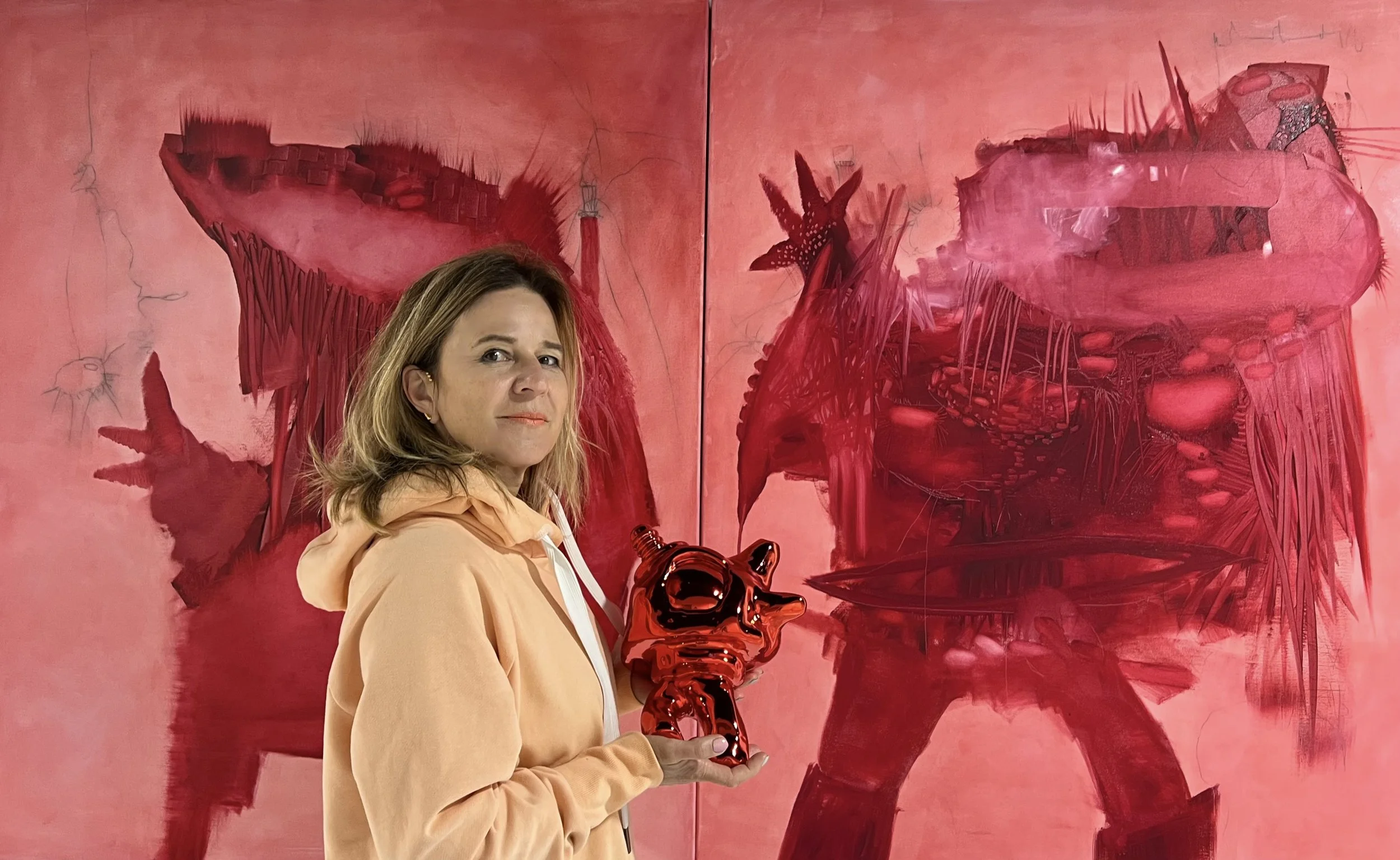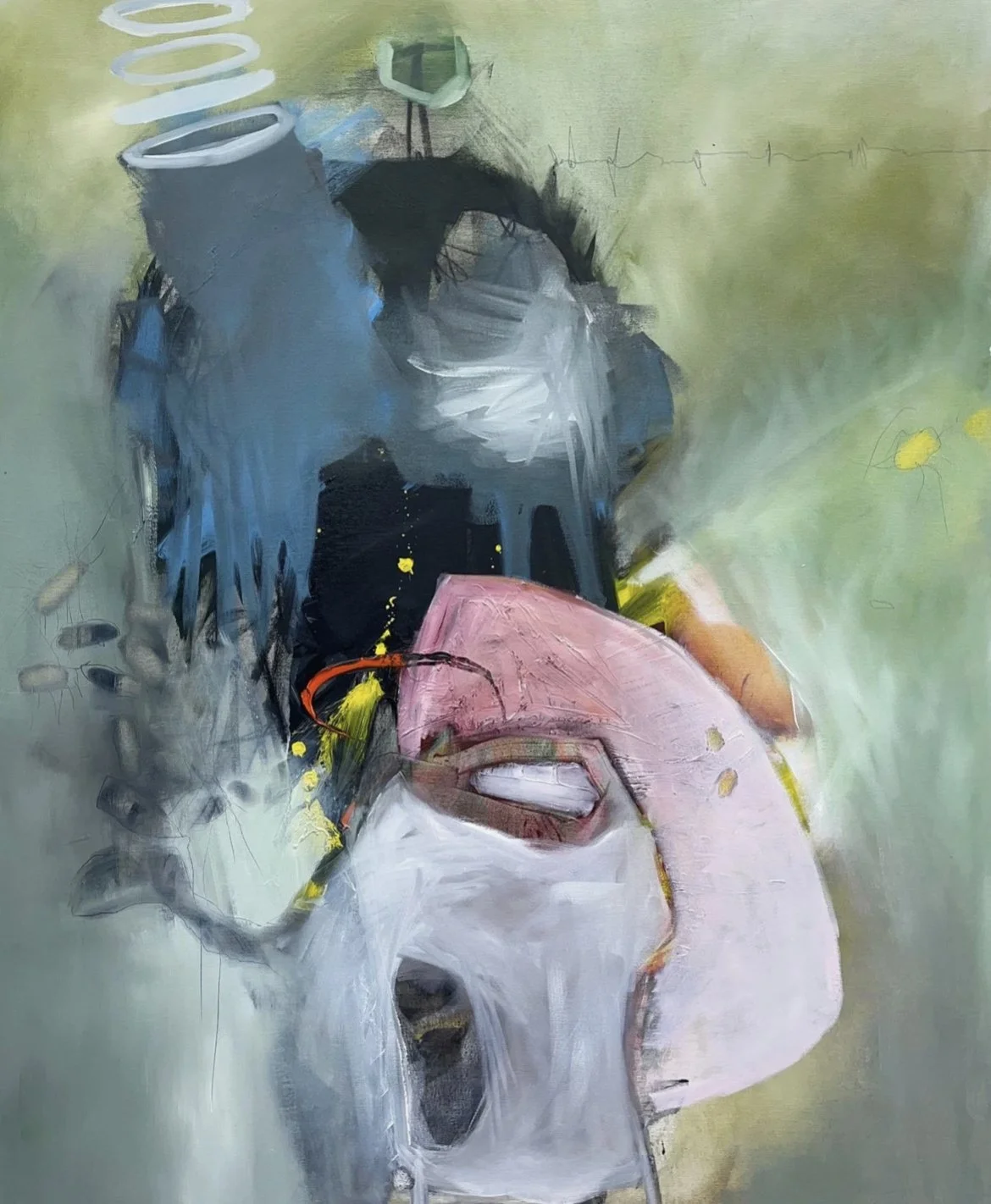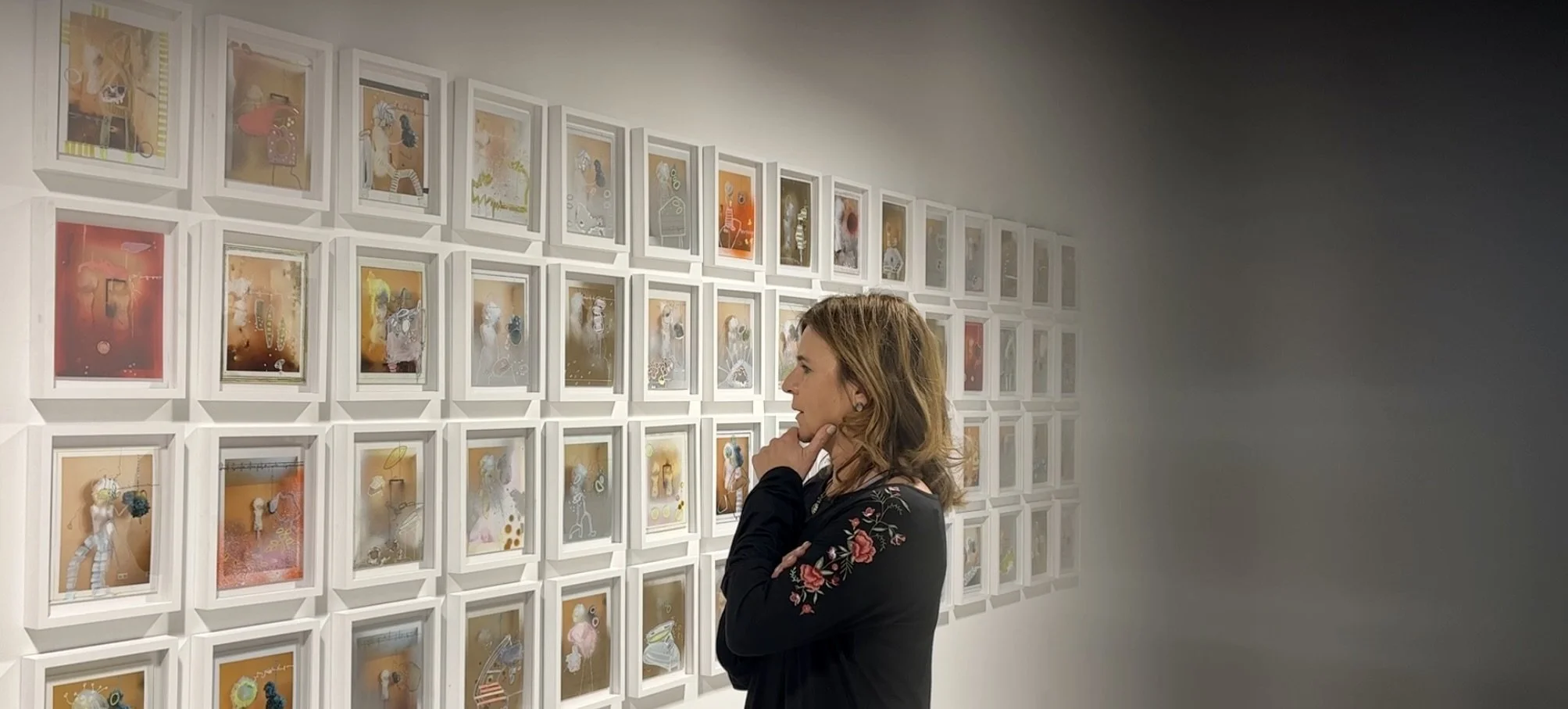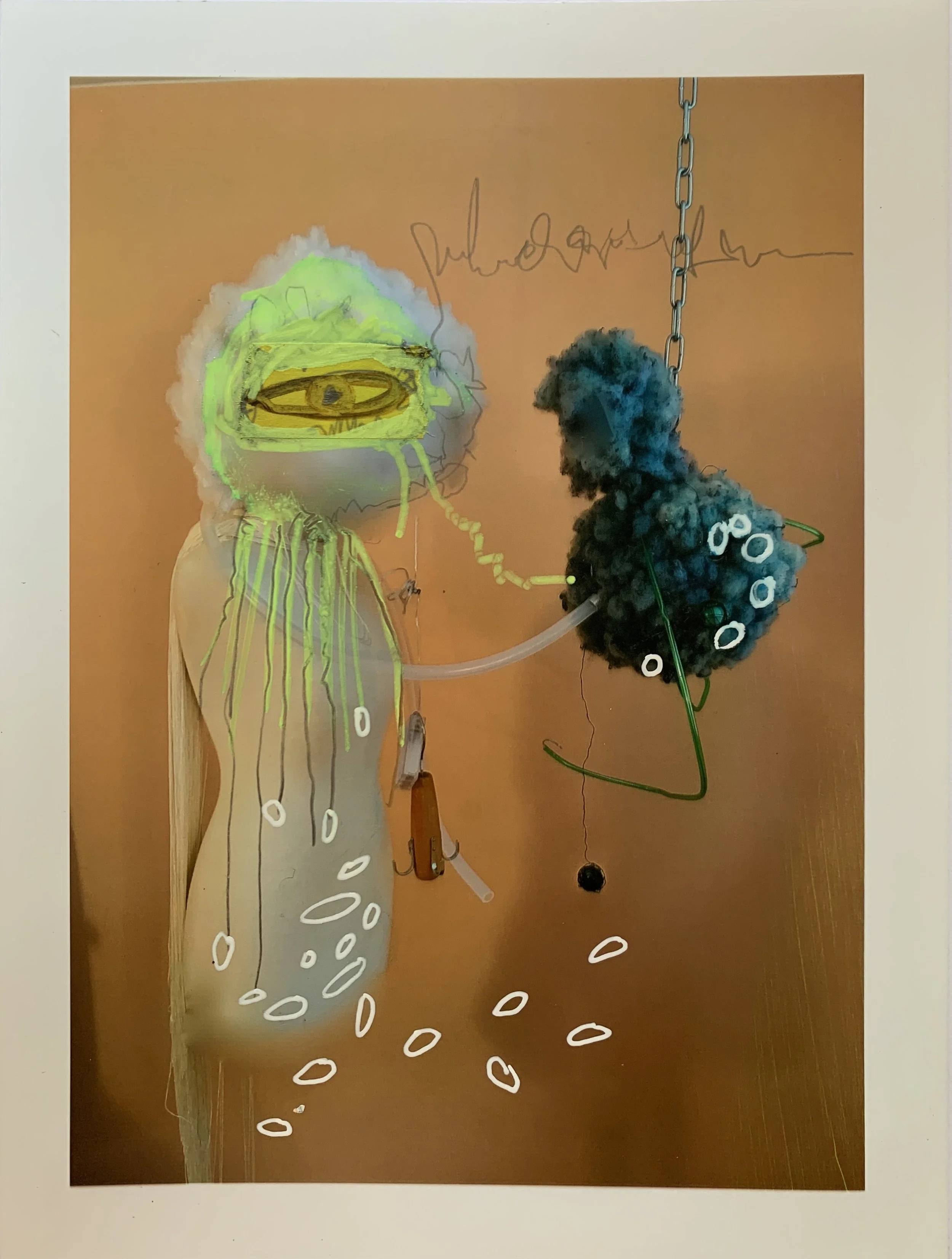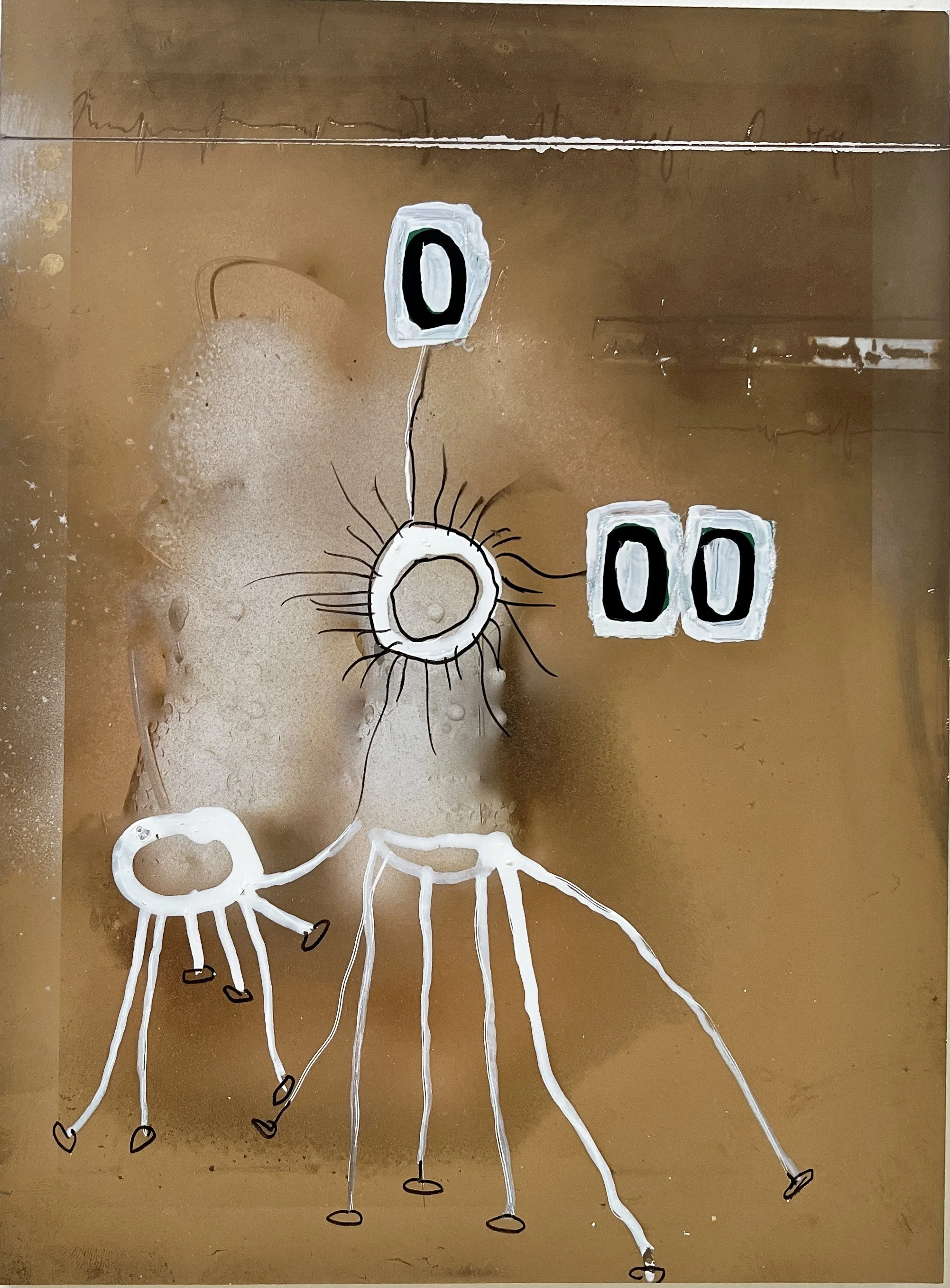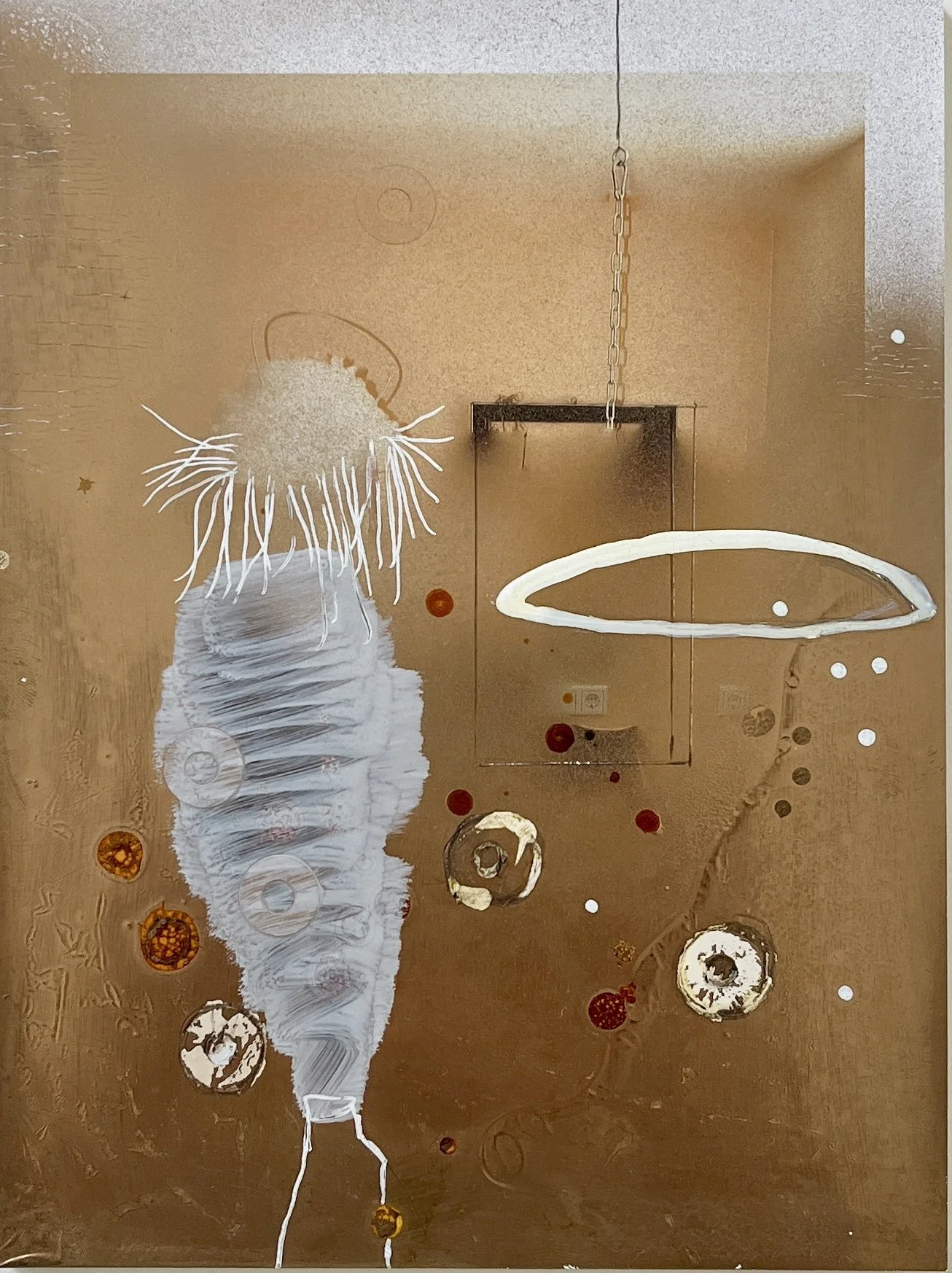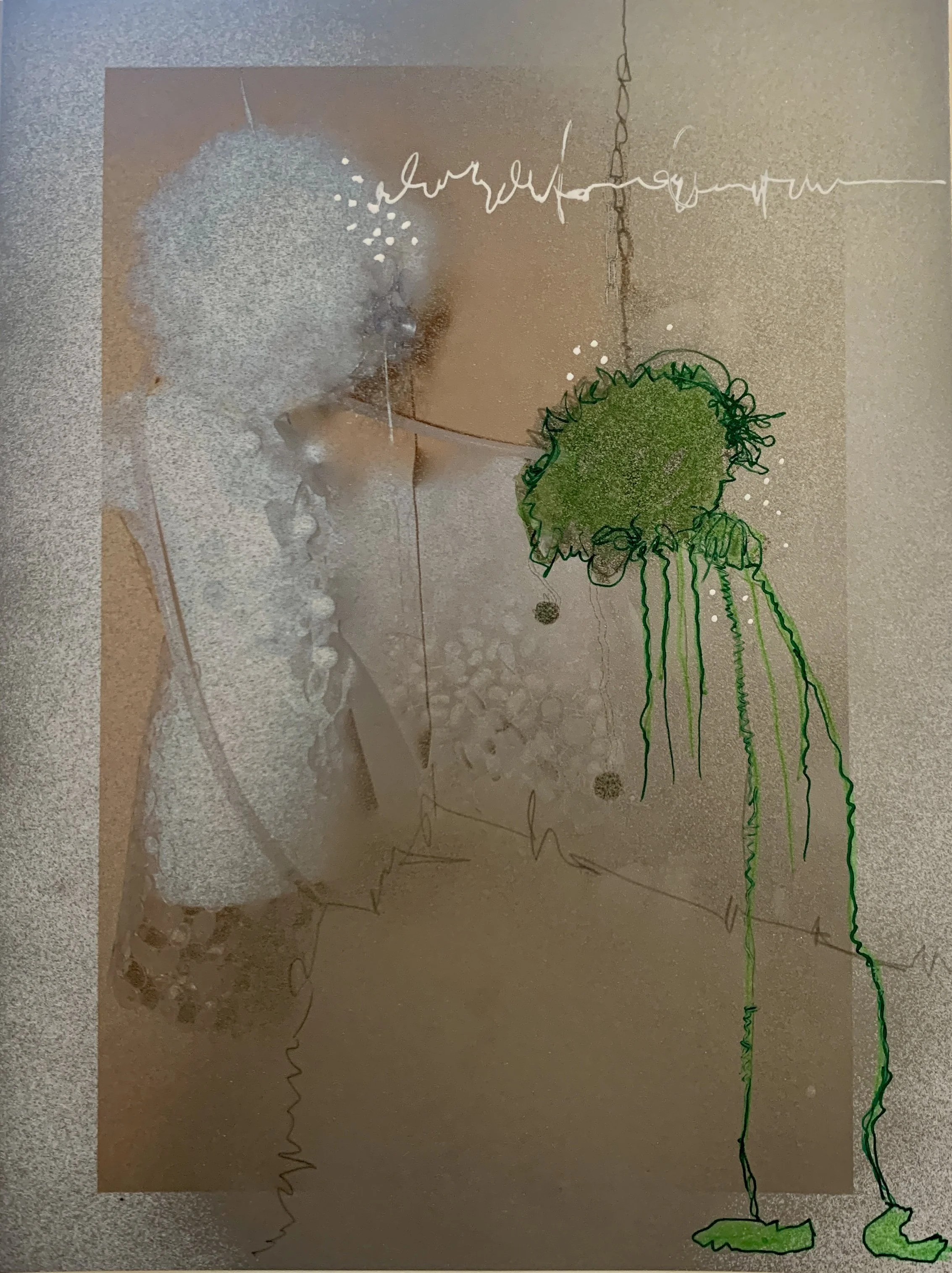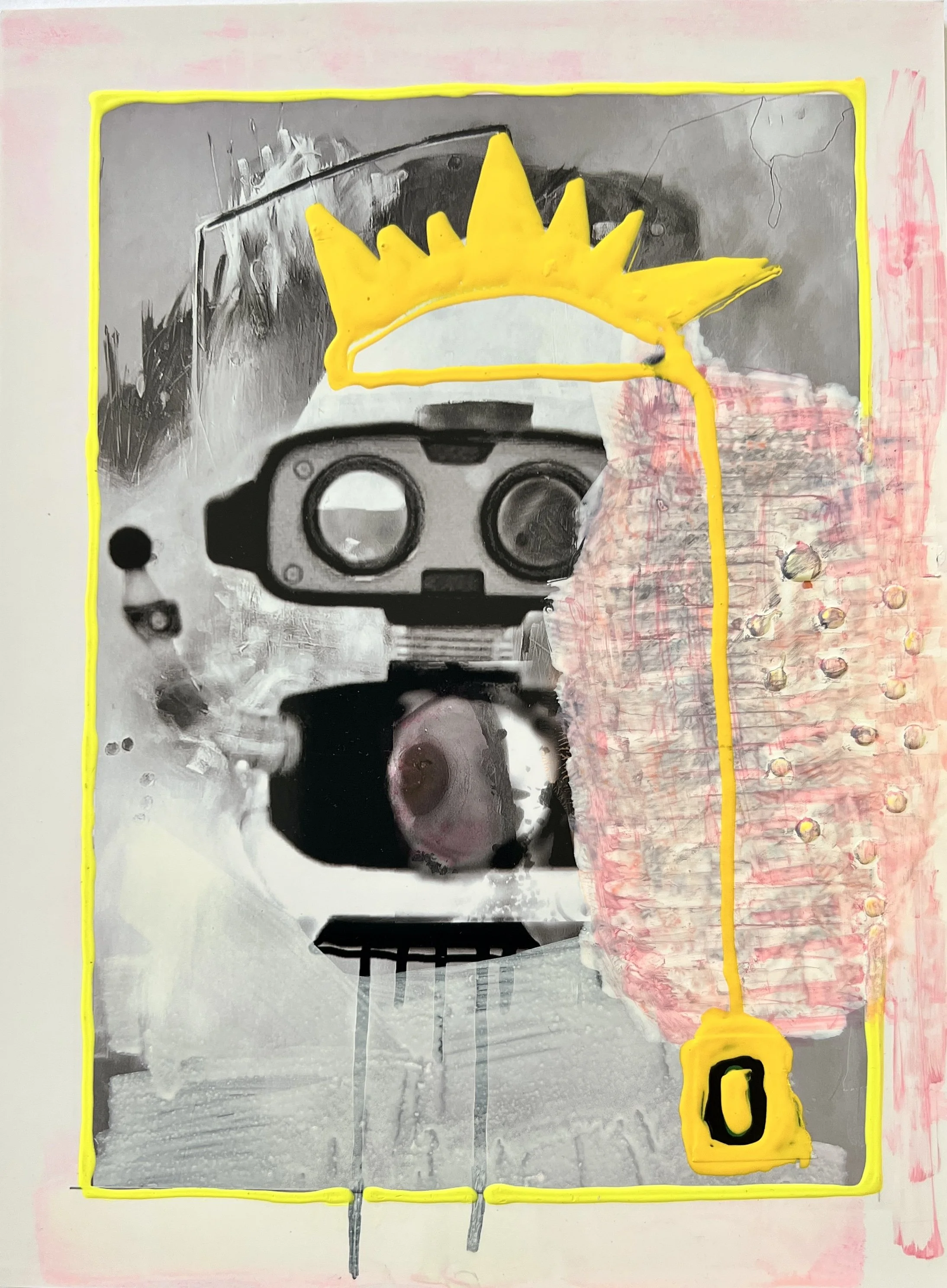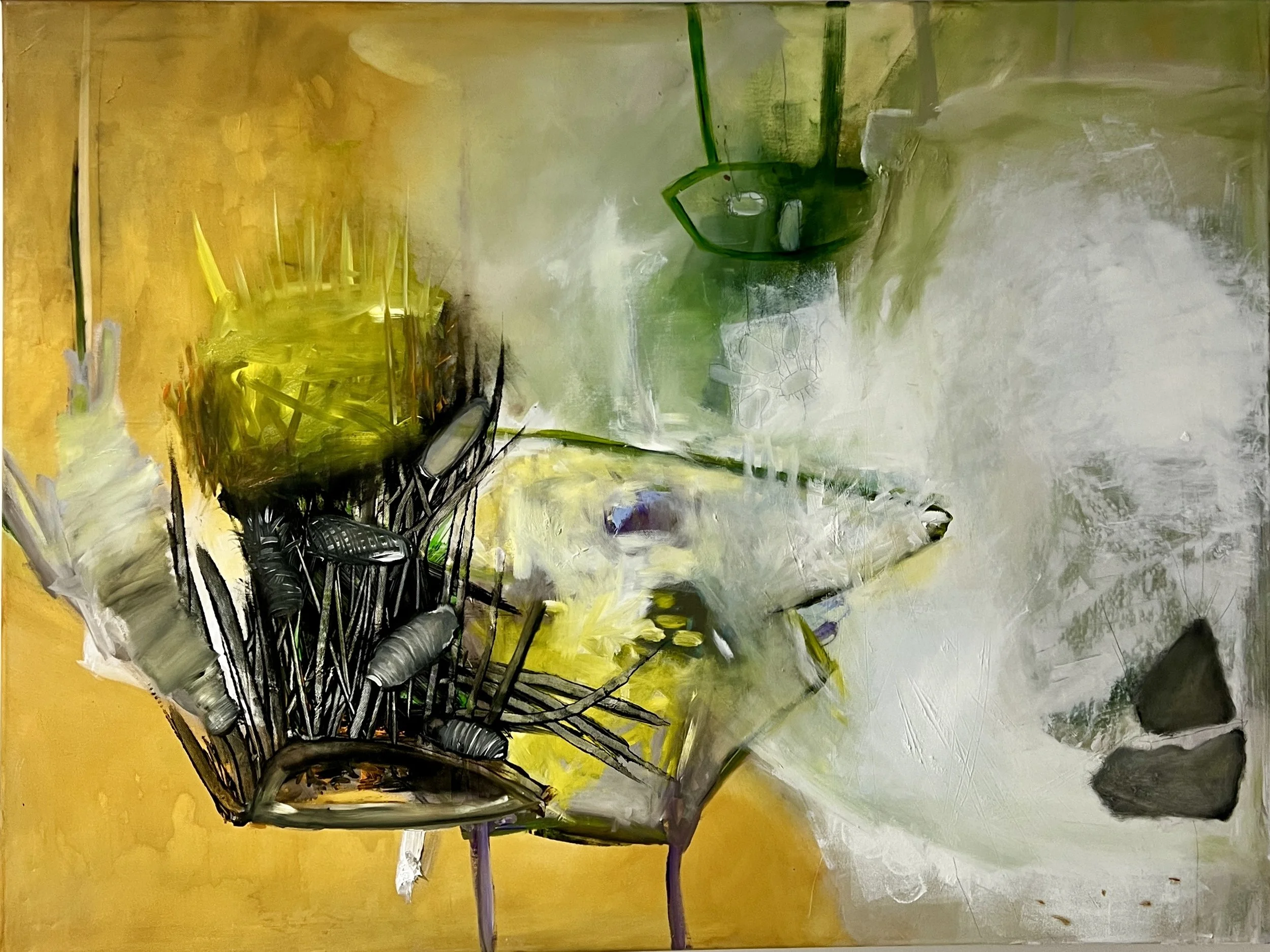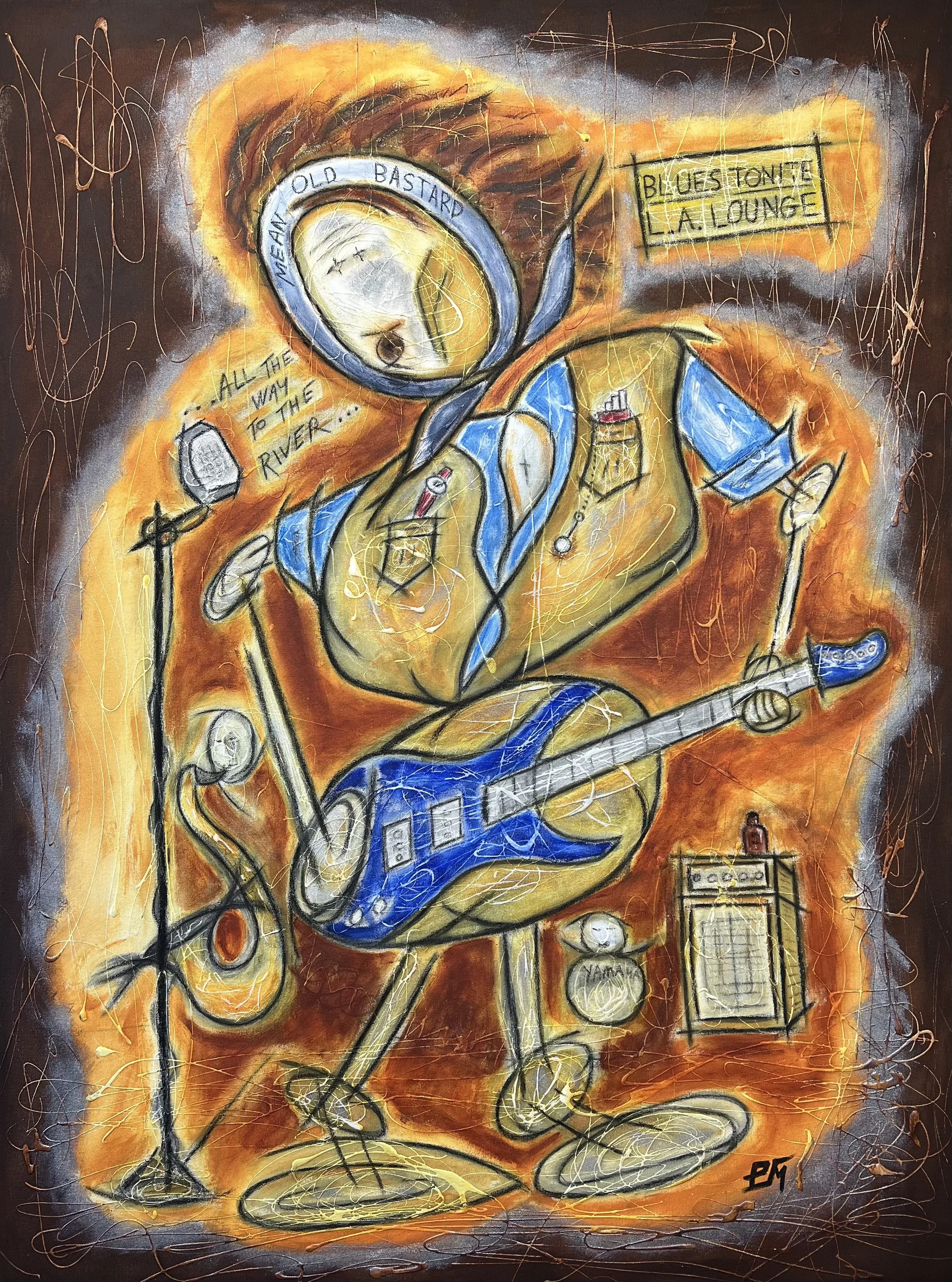Interview with Nicola Barth
Nicola Barth, born in 1966 in Mölln, now resides near Frankfurt am Main, where she pursued a master's degree in German language and literature at JW Goethe University. Her initial passion for writing books shifted as she embraced non-representational painting, seeking to express the profound and permanent metamorphosis processes that elude verbal articulation. Her art delves into the interstices of existence, merging opposites and embracing ambivalence. It reveals an unseen world beyond the obvious, inviting viewers to immerse themselves in the poetry of transitions. Nicola explores the intricacies of language and space, pondering questions of identity, fragmentation, and our place in the universe. Her works, mainly graphite and oil paintings, intermingle with three-dimensional pieces and hybrid paintings. They offer glimpses into temporal and spatially limited sections of developmental processes, reflecting the constant motion and interplay of presence and absence.
Nicola Barth with Phoenix Photon #1, 2023, unique piece, 30 x 21, 17 cm, mirrored
Paintings: Ode Ma Musis 1 and 2, Oil and pencil on canvas, 120 x100 cm, Oil on canvas
You initially studied literature before turning to painting. What was the pivotal moment or realization that led you to move from the world of words to visual art?
I can’t recall a single pivotal moment of realization—it was more of a gradual, seamless transition from literature to visual art. Looking back, I realize that I’ve always had a strong desire to express myself and communicate something in total freedom. As a student, I worked for newspapers, where I had to squeeze my thoughts into a pre-defined format under time pressure. It wasn’t what I wanted long-term, but it was an important experience that helped me realize this. I later wrote short texts, some of which were published, but I still didn’t feel “right.” The structure of language was too restrictive, too intellectual for me. Words are clear and governed by the mind, bringing us to a conformist level. Painting, however, deviates from the norm. It dives deep into an experience of being—it is a more open, direct, and intuitive form of communication that engages the senses and allows for more freedom. It’s about experiencing, not understanding.
At that time, I was unconsciously searching for a deeper, non-verbal form of expression, which I found in abstract painting. Painting came into my life almost by accident as an opportunity, and for a while, I did both—writing and painting. My academic background set high expectations for my literary work, but painting was different—there was a sense of lightness and play, a field where I could explore without restraint. Today, I can see more clearly what I wanted to convey—ideas of transformation, metamorphosis, and the invisible shifts of being were too complex and diffuse for me to fit into a structured linguistic framework. Painting allows me to touch dimensions beyond the linear structure of words. Concepts like quantum mechanics, the relationship between physical and metaphysical realities, or the tension between order and chaos can be expressed through a visual language that is more ambiguous, open, and interpretable than words.
Painting takes me to a deeper level of existence. It allows me to represent states that exist between the tangible and intangible, between form and formlessness. I don’t just depict transformation—I let it happen, layer by layer, form by form. It’s a process that doesn’t rely on the definitiveness of words but rather on the possibility of revealing and concealing things at the same time. In literature, I would have had to explain, describe, and define these concepts, but in painting, I can simply let them be. They become a visual experience that the viewer can feel and interpret without me guiding them through words. This ability to make the unspeakable visible is likely what drew me to painting.
In your transition from writing to painting, you mentioned that language was no longer sufficient for your expression. Can you describe a specific example or theme that you could convey better through painting than with words?
When I shifted from literature to painting, I realized that language was no longer enough for my expression. A specific example where I felt this strongly was the theme of metamorphosis—the idea of change that occurs both visibly and invisibly. Words, as powerful as they are, are often fixed, defining things clearly and concretely. However, I sensed a diffuseness, something ungraspable, that couldn’t be captured by language. It felt as though words couldn’t reach the depth or breadth of what I wanted to convey. What I sought to express was exactly the opposite: diffuse, floating, intangible. In painting, I can represent this diffuseness without the need to articulate it.
In my artistic practice, the three-part names I’ve been using for my paintings since 2012 play a crucial role. My works are titled "Allo Ki San," "Hono Badi Niss," "Tso Nadunie Nami." For me, these are more than just titles—they are poetic compositions that capture the essence of each work and allow for open associations. The three-part structure in the titles conveys a musical quality. It creates a rhythm, a melody, a sound that intuitively resonates with the viewer, adding an emotional layer. These titles maintain a certain ambiguity, inviting the viewer to engage with the associations and the sound of the words without offering a specific meaning or interpretation. This openness to individual interpretation and subjective perception is important to me.
Transformation is a central theme in your work. How do you implement the idea of metamorphosis in your paintings and sculptures?
Transformation and the process of metamorphosis are at the heart of my artistic work because, for me, they reflect the essence of life and existence. Everything in our universe is in a constant state of change—nothing remains static, neither matter nor mind. In my free painting, hybrid experiments, and my Phoenix-Photon sculptures, I work with this idea of metamorphosis to make the fluid and changeable visible.
Nilla Oniss Lei, Öl und Graphit auf Papier, 65 x 50 cm, 2023
In my abstract and process-oriented painting, I also incorporate this idea of transformation. I work with layers that overlap and change through the use of color and texture. In this way, the painting process itself becomes the transformation. Forms emerge and disappear, overlap, are present, and then fade again. Space is created and dissolves. My approach to painting is strongly process-oriented because I focus less on the final outcome and more on the journey. Change and metamorphosis are central not only thematically but also in the creation process itself. I often start without a fixed idea of how the work will look in the end. It’s like a dialogue between myself and the painting, where each new layer, each line, and each form reacts to the previous ones, creating something new.
For me, this process mirrors the morphological changes I want to depict. Nothing remains rigid or fixed. Everything evolves and transforms into something else, much like in nature or in our own lives. The creative process allows me to dive into this flow and physically experience the transformations I explore. In a way, my painting itself is like an organism that grows, changes, and finds its form as I work with it. This helps me understand and represent the themes of transformation and metamorphosis not only intellectually but also sensually and intuitively.
(li) Rocco La vida – God is a DJ,2022, oil on canvas, 120 x 100 x 3 cm (re)
Muus Noi Lillas, 2021, Acryl und oil on canvas, 120 x 100 x 3 cm
Alongside my free painting, I also address my central themes in specific series. For example, in the Phoenix Frequency paintings, I symbolically use gold, which for me represents golden spherical light, the primordial source of healing and transformation, and an infinite vastness in a "space that is not a space." The concept of primordial light plays a central role in many spiritual and mystical traditions. It symbolizes the original, divine light that permeates all existence, whether personal, spiritual, or universal. The phoenix, as a mythical bird, represents impermanence, rebirth, and resurrection.
Phönix-Frequenz #3, Öl Bronze on canvas, 160x120cm, 2022
In 2022, I developed my 60-piece series Raumzeit Metamorphosen (Space-Time Metamorphoses). These small-format hybrid images, a blend of pixel and pigment, represent 60 seconds in vivid worlds beyond our own. They exist in a suspended state, standing side by side as equal representations of the dynamic essence of another reality with its abundance of variations and possibilities. This series deals with transformation and metamorphosis.
Examples from 1. -4. Raumzeit, 2021, Mixed Media, Unikate, framed 26 x 20 cm
Each of the 60 small-format works originates from the same starting situation (interaction of two abstract beings/figures). The space dissolves, and the figures continuously "transform" without a linear narrative. All 60 images stand equally and simultaneously, existing in a suspended state as an idea of a dynamic essence from another reality, rich in variations and possibilities for us.
The acts of withdrawing, emerging, revealing, overlapping, and disappearing—all happen simultaneously and are allowed to coexist equally. The layers penetrate and intertwine with each other. This development, transformation, and change in form often occur "invisibly" for us, in worlds beyond, on meta-levels, in spaces that, in the truest sense, are not spaces.
Examples from 1. -4. Raumzeit, 2021, Mixed Media, Unikate, framed 26 x 20 cm
With this key body of work, I was able to demonstrate the process of transformation not only in content but also formally through hybrid painting and the alternation between analog and digital techniques.
Now, there are the Space Travelers, Octopods, and Phoenix Photons—where is the journey headed?
I am currently continuing to work with hybrid techniques similar to the Raumzeit Metamorphosen. I have chosen representatives to embody my ideas and continue telling my story—these are the Space Travelers and Octopods, as well as the Phoenix Photon. The Space Travelers and Octopods act as my "envoys" to worlds beyond, while the Phoenix Photons are the findings they bring back from their journeys. I sought out figures that represent my concept of venturing into unexplored and less obvious realms. The Space Travelers symbolize courage, curiosity, and a spirit of exploration, while the Octopods are remarkable shape-shifters, highly intelligent, and capable of communicating through the color of their skin.
In the story that accompanies the journey of these two "envoys," both bring back exactly the same finding from their experiential realms, leading to the revelation: “Phönix Photon”
Examples from the journey of Octopods and Spacemen, Mixed Media hybrid Paintings, Unikate, framed, 26 x 20 cm
Thus, there must be a surprising connection in the universe between the farthest regions of space and the deepest depths of the oceans! A connection on a deep subatomic level, a shared source, a fundamental pattern that permeates and connects everything in both realms of experience—space and deep sea. This cosmic force, capable of shaping, transforming, and regenerating life, is present in both spaces and perhaps everywhere. Therefore, there is no separation between different areas of nature, their phenomena, and life forms. Everything is alive, and everything is interconnected.
I want to continue developing this story through various artistic means and create an exciting exhibition concept around it. I would love to see my three Phoenix Photons as public art—whether inside or outside a building, or even in an open landscape. Three objects that seem to have fallen from the sky to the earth, posing mysteries and raising questions about the workings of the universe.
I’m always excited to find inspiring spaces where I can freely explore my themes—ideally in collaboration with other artists, perhaps in the context of an artist residency in an inspiring city. I also want to return to working on large-scale formats—my largest panoramic painting to date hangs in my hometown of Langen, Hesse, in the foyer of the city hall. It is 540 cm wide and 230 cm high (triptych).
You focus on language and space in your works. How do these elements interact in your creative process, and how do they shape the narratives in your art?
In the creative process, these two elements interact in various ways. Space is the medium where transformation becomes visible. It provides the context and depth within which movement, flow, and metamorphosis take place. In my painting, space is often not clearly defined—it is dynamic, opening and closing, neither entirely abstract nor figurative. I use it to relate the forms in my images to one another, to distort, dissolve, and recreate them. Space, for me, is the stage where the narrative tension between form, figure, and background unfolds. The "figures" are often hybrid beings in a state of transformation—they are embedded in the space but not entirely separated from it. These metamorphic scenarios can take place both in external and internal spaces for me.
Language and communication play a subtler but equally important role. While language took a leading position in my literary work, it steps into the background in my visual art—it becomes a cryptic script that often appears in my paintings, accompanying them and frequently embedded in the underlayers of my works. Lines like frequencies, small picture stories, and figures emerge. This fine script is a silent companion in my creative process—ambiguous and open to various interpretations.
Onanna Liwi Loop – my cosmic baby on the rocks, acrylics, oil and pencil on canvas, 150 x 240 cm, 2020
You describe yourself as a philosopher without words. How does philosophy influence your artistic process, and how do you translate philosophical concepts into visual art?
As a philosopher without words, I strive to show something in my art that I refer to as "frosted glass translucency." Words are often too concrete, too fixed. However, my works are about suggesting things that are not immediately tangible or fully transparent. Frosted glass is not completely clear—it allows light to pass through, but not in full clarity. This is similar to the themes I work with in my art: identity, metamorphoses, space-time—all of these are aspects that are constantly changing, never definitive or fully resolved. This translucency symbolizes the mysterious, something we often sense in our lives but cannot always clearly articulate. My goal is to depict this in-between space—the space between the visible and the invisible, between the known and the unknown. This is what I mean by "worlds beyond." My art invites viewers to look beyond the surface, even when not everything is immediately clear. It is this tension between what one believes they see and what remains hidden that I aim to convey.
Frosted glass is, for me, a fitting metaphor: it allows light through without making everything fully visible. This is how my art functions—translucent yet full of mysteries. I try to find a balance between the visible and the invisible, between what is immediately apparent and what can only be guessed at. There are many things we will never fully understand, but that doesn’t make them any less real. Through my art, I attempt to make these invisible aspects of existence visible.
My works exist in a space of ambiguity. I don’t provide clear answers; instead, I invite viewers to discover the art for themselves, to interpret it in their own way. There is always a mystery, something unspoken, that is not meant to be fully revealed. In my pieces, the familiar and the unknown often merge, as I explore transitions, transformations, and metamorphoses.
Ultimately, my goal is to break rigid ways of thinking and open new portals to other realities—realms that lie beyond the grasp of rational understanding.
You have received numerous awards for your artistic work. How do you think these recognitions have influenced your creative process and artistic journey? Additionally, could you share how this recognition has impacted your perception of your own art and its effect on the audience?
The awards I have received throughout my artistic career have, in some ways, strengthened my creative process, but they haven’t fundamentally changed it. They represent a form of external validation, showing me that my work is not only noticed and appreciated by myself but by others as well. This gives me courage and motivation.
Regarding my perspective on my own art, the awards have helped me develop a greater confidence in the impact my works have on the audience. Art is often a very personal, intimate endeavor, and one constantly wonders whether what is created truly resonates with others. The recognition has shown me that the themes I explore—such as transformation, space-time, or identity—trigger something in others as well, possibly even sparking deeper reflections. The audience often perceives aspects in my works that I didn’t consciously embed in them. This interaction and dialogue with viewers have broadened my view of my own art and shown me that the impact of art often goes beyond what I, as the artist, originally envisioned.
As an artist who has exhibited your work in numerous exhibitions, can you share how your approach to creating and presenting your art has evolved with each exhibition? And how have these diverse exhibition experiences influenced your artistic development and the thematic choices in your work?
With each exhibition, my approach to creating and presenting my art has changed. New spaces and the exhibition context lead me to re-evaluate and further develop my works. While my core themes, such as transformation, metamorphosis, and space-time, remain constant, the way I present them evolves with each show. The space and the context of the exhibition become part of my creative process.
This ongoing learning process, a "never-ending story" and transformation process, influences my artistic development and pushes me forward. In dialogue with the exhibition context, fellow artists, and curators, I often discover new perspectives and opportunities to expand or reimagine my central themes.
For example, my painting series Phönix Frequenzen was created when I first exhibited my Raumzeit Metamorphosen at the Incubator of Galerie Rother in Wiesbaden. Alongside the 60 Raumzeit Metamorphosen, which gave the solo exhibition its title, I was able to show a video, some moving images, and classical oil paintings. However, I felt something was missing to connect all the different mediums in a cohesive way. That’s when I created my first painting titled PHÖNIX FREQUENZ #1—and now, there are six pieces in this golden series, with surely more to come.
Last year, I had a solo exhibition at the CICA Museum, and to save on shipping costs, I had to reduce the scope of my planned show. Remarkably, I managed to fill an entire gallery space with the contents of a single suitcase.
With each exhibition, my approach to creating and presenting my art has significantly shifted. In the past, I approached my work more playfully, open to experimentation, and I gave less thought to what I was presenting to the public. It was a process of self-discovery, where I didn’t yet fully know where my artistic path would lead.
Today, it’s different. I work much more focused on my themes and am more aware of the responsibility I bear as an artist. Each exhibition presents a new opportunity, not only to show my works but to communicate my artistic intent more clearly. I’m much more conscious of what I bring into the exhibition space and how I stage my work there. It’s no longer just about exploring ideas, but intentionally conveying what is important to me—topics like transformation, hidden worlds behind, and metamorphosis.
With each new exhibition, this path becomes clearer, and I’ve learned to present my works with a clearer intention. This has also refined my artistic practice. The exhibition experiences give me the space to stay true to my own standards and artistic vision while encouraging me to grow and explore my themes more deeply.
You invite viewers to take a walk through your "worlds" and "hidden worlds behind." What do you hope viewers will discover or feel when they experience your art?
When I invite viewers to take a walk through my "worlds" or "hidden worlds behind," I hope they feel like they’re entering a different reality—one that is not fixed or definitively defined. My art is meant to open a kind of portal through which one steps into a liminal world where the familiar and the unknown merge. I’m not trying to provide clear answers, but rather to create spaces where questions arise—about identity, transformation, time, and the invisible that often lies beneath the surface.
I hope that viewers bring a certain openness and autonomy that allows them to embrace the uncertain and perhaps feel, see, or experience something they can’t immediately put into words. It’s this "frosted glass translucency" that I strive for—an atmosphere where things are hinted at but not fully revealed. If the viewer discovers something of themselves, their own thoughts or emotions in these "hidden worlds behind", then that is the moment when my art truly becomes meaningful and alive for me.
Art is ultimately about experience and self-discovery—for both the artist and those who engage with the work. I believe that as an artist, I have the opportunity and privilege to invite others to step outside of norm-bound thinking. I invite people to follow me into other spaces. If what I’ve created is good, then I’ve crafted a new kind of imaginative experience where the viewer can move and explore in a special way.
It’s also about capturing and making visible this constant state of metamorphosis. I want to show that there is so much more than we can see. A moment of mindfulness that I want to keep for myself and reveal to others. The fast pace of our society and the rapid digital advancements require us to pause, to stand still, to reflect in order to reach what lies “behind.” I paint against the dizziness that arises when the wheel spins too fast because being "at one with" or resonating with something is a way to resist the chaos—to let go of control and let oneself be carried.
I see my paintings as arbitrarily frozen snapshots of something in a continuous morphic process. Everything is always in motion, nothing stays still. Time and space are called into question. This can sometimes make us dizzy, but it also holds great opportunity, because we have the chance to recreate and transform ourselves at any moment. It would be wonderful if my paintings could inspire courage and remind people of this fantastic possibility!
Nahada Lizzi Odin, oil on canvas, 90 x 120 cm , 2024


